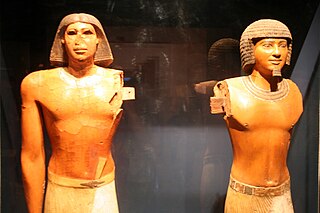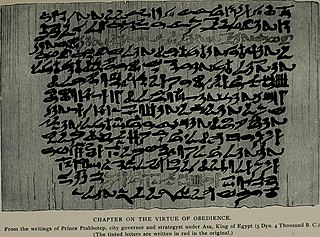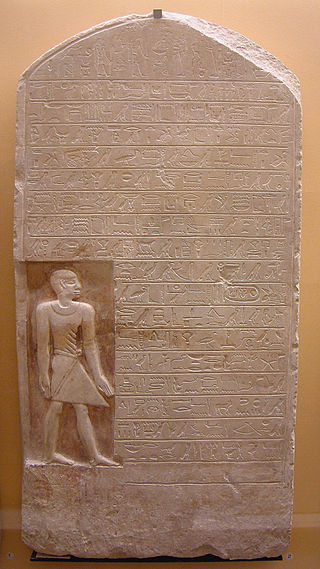Related Research Articles

Amenemhat III, also known as Amenemhet III, was a pharaoh of ancient Egypt and the sixth king of the Twelfth Dynasty of the Middle Kingdom. He was elevated to throne as co-regent by his father Senusret III, with whom he shared the throne as the active king for twenty years. During his reign, Egypt attained its cultural and economic zenith of the Middle Kingdom.

The Middle Kingdom of Egypt is the period in the history of ancient Egypt following a period of political division known as the First Intermediate Period. The Middle Kingdom lasted from approximately 2040 to 1782 BC, stretching from the reunification of Egypt under the reign of Mentuhotep II in the Eleventh Dynasty to the end of the Twelfth Dynasty. The kings of the Eleventh Dynasty ruled from Thebes and the kings of the Twelfth Dynasty ruled from el-Lisht.

Pepi II Neferkare was a pharaoh of the Sixth Dynasty in Egypt's Old Kingdom who reigned from c. 2278 BC. His second name, Neferkare (Nefer-ka-Re), means "Beautiful is the Ka of Re". He succeeded to the throne at age six, after the death of Merenre I.

Userkare Khendjer was the twenty-first pharaoh of the Thirteenth Dynasty of Egypt during the Second Intermediate Period. Khendjer possibly reigned for four to five years, archaeological attestations show that he was on the throne for at least three or four years three months and five days. Khendjer had a small pyramid built for himself in Saqqara and it is therefore likely that his capital was in Memphis.

The Ipuwer Papyrus is an ancient Egyptian hieratic papyrus made during the Nineteenth Dynasty of Egypt, and now held in the Dutch National Museum of Antiquities in Leiden, Netherlands. It contains the Admonitions of Ipuwer, an incomplete literary work whose original composition is dated no earlier than the late Twelfth Dynasty of Egypt.

Ptahhotep, sometimes known as Ptahhotep I or Ptahhotpe, was an ancient Egyptian vizier during the late 25th century BC and early 24th century BC Fifth Dynasty of Egypt.

Khaneferre Sobekhotep IV was one of the more powerful Egyptian kings of the 13th Dynasty, who reigned at least eight years. His brothers, Neferhotep I and Sihathor, were his predecessors on the throne, the latter having only ruled as coregent for a few months.

The Maxims of Ptahhotep or Instruction of Ptahhotep is an ancient Egyptian literary composition composed by the Vizier Ptahhotep around 2375–2350 BC, during the rule of King Djedkare Isesi of the Fifth Dynasty. The text was discovered in Thebes in 1847 by Egyptologist M. Prisse d'Avennes. The Instructions of Ptahhotep are considered didactic wisdom literature belonging to the genre of sebayt. There are four copies of the Instructions, and the only complete version, Papyrus Prisse, is located in the Bibliothèque Nationale in Paris. According to William Kelly Simpson, some scholars debate that the Instructions of Ptahhotep were written during the twelfth dynasty, Middle Kingdom. The earlier copies of the text were altered to make them understandable for the Egyptians of the New Kingdom. The text presents a very good picture of the general attitudes of that period. The Instructions of Ptahhotep addresses various virtues that are necessary to live a good life and how to live accordingly to Maat, which was an important part of the Egyptian culture.
Sebayt is the ancient Egyptian term for a genre of pharaonic literature. sbꜣyt literally means "teachings" or "instructions" and refers to formally written ethical teachings focused on the "way of living truly". Sebayt is considered an Egyptian form of wisdom literature.

Ankhu was an Egyptian vizier of the early 13th Dynasty, who lived around 1750 BC.

Ancient Egyptian literature was written in the Egyptian language from ancient Egypt's pharaonic period until the end of Roman domination. It represents the oldest corpus of Egyptian literature. Along with Sumerian literature, it is considered the world's earliest literature.

The Loyalist Teaching, or The Loyalist Instructions, is an ancient Egyptian text of the sebayt ('teaching') genre. It survives in part from a stela inscription of the mid Twelfth dynasty of Egypt. The whole text can be found in papyrus scrolls of the New Kingdom period. Its authorship is uncertain, although it has been suggested that it was written by the vizier Kairsu of the early Twelfth dynasty. The text emphasizes the virtues of loyalty to the ruling pharaoh and the responsibilities one must maintain for the sake of society.

Neferkare Iymeru was the ancient Egyptian vizier under king Sobekhotep IV in the 13th Dynasty, in the Second Intermediate Period.
The Papyrus Boulaq 18 is an ancient Egyptian administrative document. It contains an account of the Theban palace dating to the 13th Dynasty. The papyrus lists the palace officials and the rations they received day by day. Important officials mentioned are, for example, the vizier Ankhu, but also the queen Aya. Therefore, the document is of great historical importance. It also reports the journey of the king to the temple at Medamud and reports the arrival of a delegation of Nubians.
The Papyrus Salt 124 is an ancient Egyptian papyrus dating to the beginning of the 20th Dynasty. This papyrus is a copy of a letter addressed to the vizier of the time, most likely Hori.

Zamonth or Samont was an ancient Egyptian vizier who was in office at the end of the Twelfth Dynasty, around 1800 BC.

Iymeru was an ancient Egyptian vizier in office during the 13th Dynasty.
Dedusobek Bebi was a high official of the late Thirteenth Dynasty of ancient Egypt. He became the "Great Scribe of the Vizier". This position was directly under the Vizier acting as a deputy.
The Brooklyn Papyrus 35.1446 is the modern term for an ancient Egyptian document that is now in the Brooklyn Museum.
The overseer of fields was one of the highest court officials at the Egyptian royal court. The title appears first in the provincial administration of the Old Kingdom and is attested in the First Intermediate Period at the royal court. In the early Middle Kingdom it is again best attested at provincial level. In the late Middle Kingdom they regularly bear the title royal sealer, indicating that they now belonged to the royal court. In the Middle Kingdom is also attested the scribe of the fields who evidently worked under the overseer of fields.